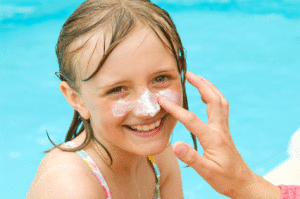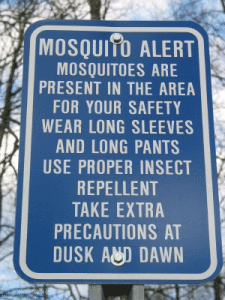Sunscreens
Sunscreens and mosquito repellents are among the most common medical products used in the summer months. The rays emitted by our powerful sun are in the Ultraviolet (UV) range, which is composed of UVA and UVB rays. Protection from both UVA (phototoxicity and photoaging) and UVB (sunburn) is important. The SPF, which stands for Sun Protection Factor, is what most people go by when choosing a sunscreen. What most people don’t know is that SPF refers to protection from UVB, NOT from UVA rays. Products containing several ingredients, which together are capable of absorbing UV radiation in varying ranges (both UVA and UVB), are referred to as “Broad Spectrum” and are the preferred products.
After 33 years of consideration, the FDA will soon come out with rules that specify which lotions provide the best protection against the sun and will end claims that sunscreens are truly waterproof or sweatproof. Because these products are not truly waterproof, the manufacturers will instead be allowed to claim in minutes the amount of time the product is water resistant, depending upon test results. The manufacturers will also rate a product’s ability to provide protection against UVA radiation right next to its protection against UVB with a “star” system. One star indicates low UVA protection, 2 stars is medium, 3 stars reflect high and 4 stars is the highest UVA protection available over-the-counter.
 There are numerous sunscreen products available in a wide variety of delivery mechanisms such as lotions, foams, gels, sticks, creams, sprays, oils and lip balms. Regardless of the specific sunscreen used, perhaps the most important fact for families to understand and appreciate is the amount and frequency of application. Most sunscreen users do not apply enough sunscreen, and do not apply it frequently enough.
There are numerous sunscreen products available in a wide variety of delivery mechanisms such as lotions, foams, gels, sticks, creams, sprays, oils and lip balms. Regardless of the specific sunscreen used, perhaps the most important fact for families to understand and appreciate is the amount and frequency of application. Most sunscreen users do not apply enough sunscreen, and do not apply it frequently enough.
- Put sunscreen on 30 minutes before going outdoors. It needs time to absorb into the skin.
- Use enough sunscreen to cover all exposed areas, especially the face, nose, ears, feet, and hands and even the backs of the knees. Rub it in well.
- For Babies younger than 6 months. Use sunscreen on small areas of the body, such as the face and the backs of the hands, especially if protective clothing and shade are not available.
- For babies older than 6 months. Apply to all areas of the body, but be careful around the eyes. If your baby rubs sunscreen into her eyes, wipe the eyes and hands clean with a damp cloth. If the sunscreen irritates her skin, try a different brand, a sunscreen stick, or a sunscreen with titanium dioxide or zinc oxide. If a rash develops, give us a call.
- Use sunscreen any time you or your child are outdoors and especially if you might sunburn. Remember that you can get a sunburn even on cloudy days. Also, UV rays can bounce back from water, sand, snow, and concrete and cause sunburn so make sure you’re protected.
- Reapply sunscreen every 2 hours. Sunscreen wears off after swimming, sweating, or just from soaking into the skin.
Most dermatologists recommend looking for products that say “broad spectrum” on the label with an SPF between 30 to 50 and to reapply the sunscreen every 1-2 hours.
Other tips to protect your family from sunburns now and from skin cancer later in life:
- Keep babies younger than 6 months out of direct sunlight. Find shade under a tree, umbrella, or the stroller canopy.
- When possible, dress yourself and your kids in cool, comfortable clothing that covers the body, like lightweight cotton pants, long-sleeved shirts, and hats.
- Select clothes made with a tight weave – they protect better than clothes with a looser weave. If you’re not sure how tight a fabric’s weave is, hold it up to see how much light shines through. The less light, the better.
- Wear a hat or cap with a brim that faces forward to shield the face.
- Limit your sun exposure between 10:00 am and 4:00 pm, when UV rays are strongest.
- Wear sunglasses with at least 99% UV protection (look for child-sized sunglasses with UV protection for your child).
- Set a good example. You can be the best teacher by practicing sun protection yourself. Teach all members of your family how to protect their skin and eyes.
Insect Repellants

The FDA does not regulate active ingredients found in insect repellent products. Instead, the Environmental Protection Agency (EPA) regulates active ingredients found in insect repellent products for efficacy and safety. Insect repellents come in many forms including aerosols, sprays, liquids, creams, and sticks. Some are made from chemicals and some have natural ingredients. Seven active ingredients are registered with the EPA as insect repellents (for direct application to skin). These ingredients include DEET (N,N-diethyl-m-toluamide), picaridin, oil of lemon eucalyptus, oil of citronella, and IR3535. Oil of lemon eucalyptus, oil of citronella and IR3535 are considered “biopesticide repellents,” as they are produced from natural materials. These ingredients may appeal to users who prefer to apply natural products. Some commercially available insect repellent ingredients are not required to be registered with the EPA, including peppermint, peppermint oil and soybean oil. Although these active ingredients have been previously evaluated for safety and found to possess minimal risk from use, the EPA has not evaluated them for effectiveness. The EPA is, however, currently re-evaluating this regulatory process.
Keep in mind that insect repellents prevent bites from biting insects but not stinging insects. Biting insects include mosquitos, ticks, fleas, chiggers, and biting flies. Stinging insects include bees, hornets, and wasps.
The following are types of repellents that are NOT effective:
- Wristbands soaked in chemical repellents
- Garlic or vitamin B1 taken by mouth
- Ultrasonic devices that give off sound waves designed to keep insects away
- Bird or bat houses
- Backyard bug zappers (Insects may actually be attracted to your yard.)
DEET is likely the most commonly available and used insect repellent in the United States. The CDC said that DEET and picaridin have demonstrated greater efficacy than the active ingredients of other insect repellent.
The amount of DEET in insect repellents varies from product to product, so it’s important to read the label of any product you buy. The amount of DEET may range from less than 10% to more than 30%.
Studies show that products with higher amounts of DEET protect people longer. For example, products with amounts around 10% may repel pests for about 2 hours, while products with amounts of about 24% last an average of 5 hours. But studies also show that products with amounts of DEET greater than 30% don’t offer any extra protection.
The following are guidelines on how to use insect repellents safely:
Dos:
- Read the label and follow all directions and precautions.
- Only apply insect repellents on the outside of your child’s clothing and on exposed skin.
- Spray repellents in open areas to avoid breathing them in.
- Use just enough repellent to cover your child’s clothing and exposed skin. Using more doesn’t make the repellent more effective. Avoid reapplying unless necessary.
- Assist young children when applying insect repellents on their own. Older children also should be supervised when using these products.
- Wash your children’s skin with soap and water to remove any repellent when they return indoors, and wash their clothing before they wear it again.
Don’ts:
- Never apply insect repellent to children younger than 2 months.
- Repellents should not be sprayed directly onto your child’s face. Instead, spray a little on your hands first and then rub it on your child’s face. Avoid the eyes and mouth.
- Insect repellents should not be applied on cuts, wounds, or irritated skin.
- Don’t buy products that combine DEET with sunscreen. The DEET may make the sun protection factor (SPF) less effective. These products can overexpose your child to DEET because the sunscreen needs to be reapplied often.
Parents often worry about the potential for adverse effects, especially when DEET is on the skin for many hours. DEET has been used as a commercially available insect repellent for more than 50 years, and in this time (and considering how commonly it is used), relatively few reports of significant adverse effects or toxicity have been reported. In a recent review of insect repellents, a group of researchers describes 43 case reports of DEET toxicity during a 50-year period. Most reported adverse effects have also been attributed to inappropriate use such as ingestion of the product. Several other reviews of DEET toxicity, such as data from poison control centers, have also concluded that risk of toxicity from use of DEET is very low in children. Examples of inappropriate use of DEET identified in several studies include leaving DEET on the skin overnight and direct application to the face (in which increased absorption may occur through mucous membranes).
The American Academy of Pediatrics (AAP) recommends that repellents contain no more than 30% DEET when used on children. Insect repellents also are not recommended for children younger than 2 months. Some users may not like the oily feel that DEET can impart to skin once applied. DEET can also damage some clothing fabrics, including spandex, rayon and certain leathers. It may also damage some plastics (such as on watches and eyeglasses) and vinyl.
Picaridin has more recently become available in the United States and has been described as an effective, non-DEET insect repellent. It is available in several products at 7% and 20% concentrations. Duration of protection is approximately 4 to 5 hours with a 20% concentration.
Adapted directly from NYtimes article published 6/14/11 titled “F.D.A. Unveils New Rules About Sunscreen Claims” and an article from the Pediatricsupersite by Edward A. Bell, PharmD, BCPS and from the Amerian Academy of Pediatrics (www.healthychildren.org).
